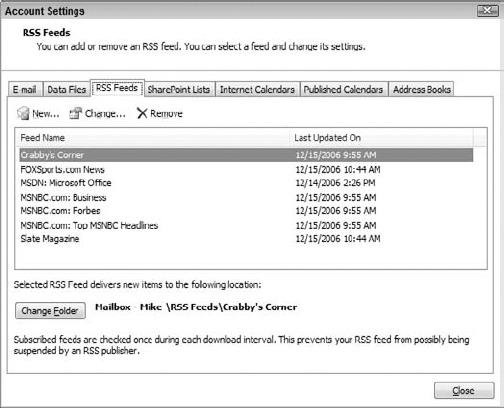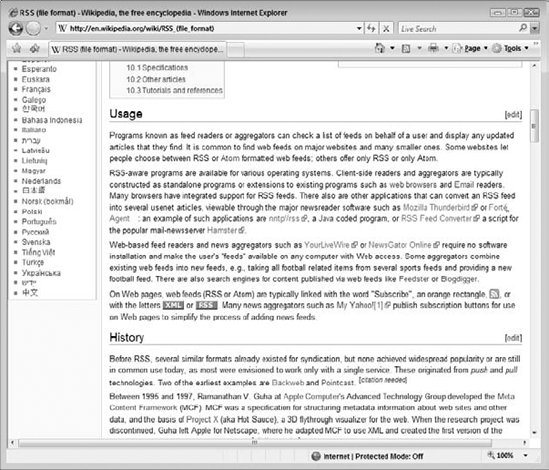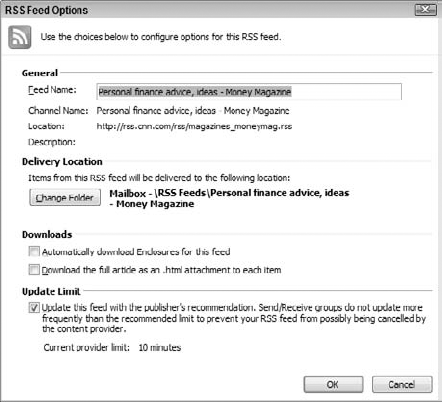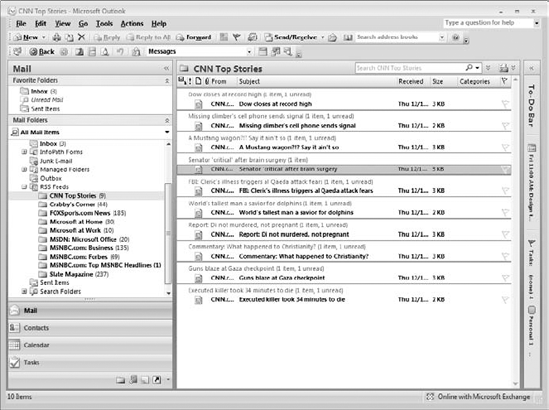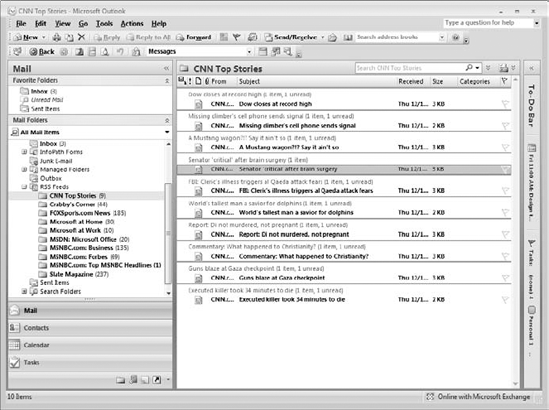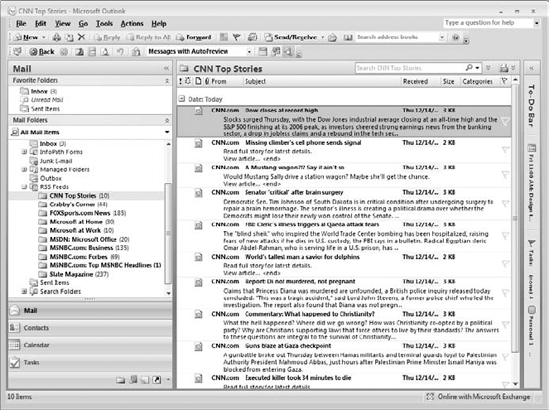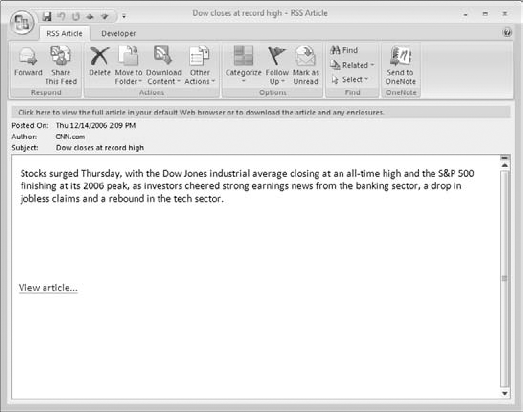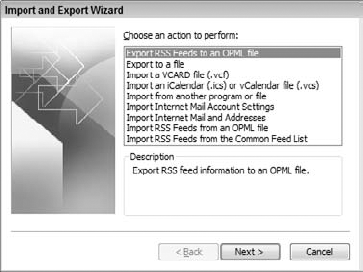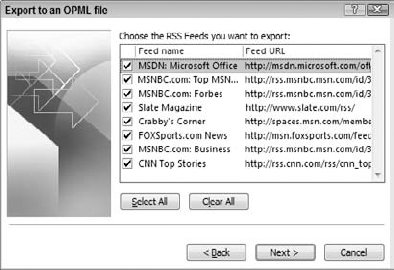Understanding RSS feeds
Subscribing to RSS feeds
Viewing RSS feeds
Deleting and changing RSS feeds
Importing and exporting collections of RSS feeds
RSS stands for Really Simple Syndication, a family of web feed formats that are used to deliver content over the Internet. The term syndication refers to the fact that you subscribe to one or more specific feeds and your software—Outlook in this case—automatically receives the files and displays the information they contain. You can subscribe to RSS feeds on just about any topic you can imagine—news, sports, finance, weather...you name it.
Though most people interpret RSS to stand for Really Simple Syndication, the fact is that it is a whole family of syndication formats that includes Really Simple Syndication as well as Rich Site Summary and RDF Site Summary. But in reality, the precise syndication format is irrelevant to you, the end user, as long as you get the information you want.
RSS is particularly useful because it lets you combine information from a variety of sources in one location. No longer do you have to visit separate web sites for news, weather, stock reports, and so on. Instead you can subscribe to the RSS feed from each of the web sites and then have titles or brief summaries displayed in your RSS reader. When a title catches your interest, click the link to read the entire article.
Most modern web browsers support RSS feeds, and there are also many stand-alone programs, many of them free, for this purpose. Why then use Outlook? For me, it's a matter of having one place where I go for all sorts of information. I go to Outlook for email, appointments, contact information, tasks, and so on—why not for news and other RSS feeds?
In Outlook, an RSS feed is considered to be a kind of account. Accordingly, you subscribe to feeds and edit or delete existing subscriptions in the Account Settings dialog box. To display RSS feed accounts, select Account Settings from the Tools menu and click the RSS Feeds tab. The dialog box is shown in Figure 16.1. In the figure, there are several RSS feeds listed, but if you are just getting started the list will be empty.
To subscribe to an RSS feed you must know its URL. This is similar to the URL for a web page and will have this general form:
http://rss.somesite.com/rss/news.rss
The file extension may be .RSS as in this example or it may be .XML. There are two ways to get the URL for an RSS feed. In one situation, the URL may be listed on the web site that offers the subscription, and you can simply copy and paste it into Outlook or just type it in. However, some web sites display small buttons that visitors can click to subscribe their browser to the feed. The most commonly used icons are shown in Figure 16.2.
When only an RSS button is displayed on a web site and not the URL of the feed, here's how to get the URL:
Right-click the button to display a context menu.
From the menu select Copy Shortcut (in Internet Explorer) or Copy Link Location (in Firefox) to copy the URL to the Windows Clipboard.
Once you have the URL of the RSS feed, here's how to subscribe Outlook to the feed:
On the RSS Feeds tab of the Account Settings dialog box, click the New button to display the New RSS Feed dialog box (see Figure 16.3).
Paste or type the feed URL into the box.
Select Add to display the RSS Feed Options dialog box as shown in Figure 16.4.
Set options as described here (although these options rarely need changing):
Feed Name: You can accept the default feed name or enter your own. This name is displayed in Outlook to identify the feed.
Change Folder: If you want to change the folder where download feed items are kept, click this button. There is rarely a reason to do this.
Automatically Download Enclosures...: If you select this option, any enclosures that the RSS feed provides will be downloaded automatically when the feed is updated and not just when you view the feed.
Download the Full Article...: If you select this option, full articles will be downloaded automatically when the feed is updated rather than just on demand when you open them. This increases update time but lets you read articles when you are offline.
Update Limit: If this option is selected (recommended), the RSS feed will be updated at the publisher's recommended interval. If you turn this option off, Outlook may try to update the feed more often, which can cause your subscription to be cancelled.
Click OK to return to the Account Settings dialog box.
RSS feeds that you are subscribed to are displayed in the Outlook folder display in the navigation pane, as shown in Figure 16.5. The number next to each feed tells you the number of unread items in the feed.
To display a list of the items in a feed, click it. The items are displayed in a list in Outlook's main window, as shown in Figure 16.6. Each item's title is displayed, although you can change this as I explain soon. In many ways, feed items are like email messages—you can assign them to categories, flag them for follow up, forward an item to an email recipient, and so on.
By default, RSS feed items are arranged by date received, with the newest at the top of the list. You can change this by selecting Arrange By from the View menu and then selecting the desired arrangement from the next menu.
You can also change the item display to show not only the title of each item but a brief synopsis (if provided by the feed publisher). To do so, select AutoPreview from the View menu. The display of RSS feed items with AutoPreview is shown in Figure 16.7. Select the same command again to turn AutoPreview off.
When you open an RSS item by double-clicking it, it opens it its own window as shown in Figure 16.8. You can see that a summary of the article is displayed as well as a link to the full article (the link says "View Article"). At this point there are two slightly different things that you can do to read the article and any associated content:
View the article: By clicking the View Article link you display the article in your default browser. This is just like viewing a web page.
Download the article and any content: By clicking the Download Content button on the ribbon and then selecting Download Article, you download a copy of the article to your computer. It displays as an attachment to the RSS item, as shown in Figure 16.9. You can open this attachment to view in your browser.
The difference here is that in the second case you have a local copy of the article on your computer, whereas in the first case you do not. Note that if you select the Download the Full Article option when setting up the RSS feed account, this download happens automatically.
Other actions you can take with an open RSS item include:
Forward: Click the Forward button on the ribbon to create a new email message with the article summary in the body and the full article attached. You can edit the message, address it, and send it to other people.
Share This Feed: Click the Share This Feed button on the toolbar to create a new email message that contains information about the RSS feed. Then, address and send the message to whomever you desire. The recipients can then subscribe to the feed if they find it interesting.
To delete an RSS feed, you can right-click it in the folders list and select Delete from the context menu. You can also display the RSS Feeds tab of the Account Settings dialog box (select Account Settings from the Tools menu), click the RSS Feeds tab, click the feed you want to delete, and click Remove.
You can also modify the settings for a feed by selecting it in on the RSS Feeds tab of the Account Settings dialog box and clicking Change. The RSS Feed Options dialog box is displayed (shown earlier in Figure 16.4) where you can make the desired changes.
Outlook supports the ability to import and export collections of RSS feed configuration information. This information is stored in an XML file that has the .opml extension (which stands for Outline Processor Markup Language). This file can be forwarded by email or stored on a central server and made available to employees. For example, a stock brokerage firm could put together a list of RSS feeds that it thinks would be useful to its brokers.
To export an RSS feed collection:
Select Import and Export from the File menu to display the Import and Export Wizard (see Figure 16.10).
Select Export RSS Feeds to an OPML File.
Click Next. Outlook displays a list of RSS feeds that are defined in Outlook—in other words, feeds that you have subscribed to (see Figure 16.11).
Put checkmarks next to the RSS feeds you want to export and clear those that you do not want to export.
Click Next.
Enter the name of the file to export to, or click the Browse button to change folders and specify a name, then click Save.
Importing RSS information from an OPML file is essentially the reverse of the previous process:
Select Import and Export from the File menu to display the Import and Export Wizard.
Select Import RSS Feeds from an OPML File.
Click Next.
Enter the name of the file, or use the Browse button to find it.
Click Next.
In the next dialog box, put a checkmark next to the feeds that you want to import and clear those that you do not want to import.
Click Next.
Microsoft's web browser, Internet Explorer, can also be used as an RSS aggregator. If you have version 7 or later of the browser, it has the capability to share RSS feed information with Outlook—this is called the common feed list. In other words, RSS feeds you have subscribed to in Internet Explorer are available in Outlook, and vice versa.
When Outlook detects a compatible version of Internet Explorer, it asks you whether you want to combine and synchronize the lists. Select Yes if you want to be able to view all your RSS feeds in either program, both existing feeds and ones you add in the future. Select No to keep a separate list of RSS subscriptions in each program.
If you decide not to combine the RSS subscriptions for Outlook and Internet Explorer, you can always import subscriptions from the common feed list at a later time. The process is very similar to importing from an OPML file except that there is no file involved:
Select Import and Export from the File menu to display the Import and Export Wizard.
Select Import RSS Feeds from the Common Feed List.
Click Next.
In the next dialog box, put a checkmark next to the feeds that you want to import and clear those that you do not want to import.
Click Next.
Click Finish.
Really Simple Syndication, or RSS, is an excellent way to keep track of updated information from a wide variety of sources. Many different web sites publish RSS feeds on just about any topic you can imagine. Outlook's RSS aggregator tools let you subscribe to and view RSS feeds in the same program that you use for email, contacts, and appointments.

